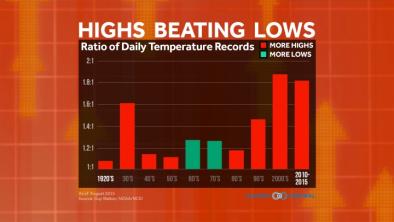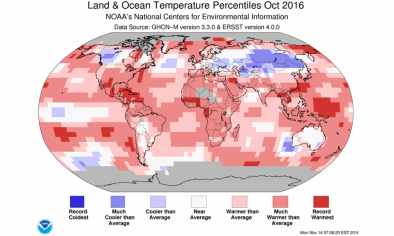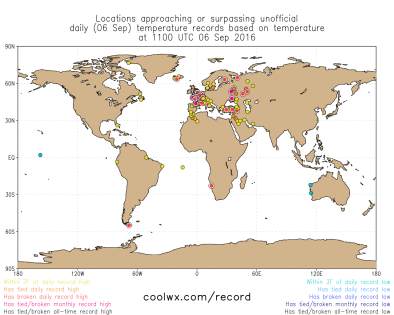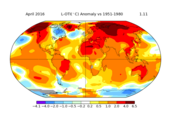Global Heat Records 2016
Temperatures in 2016 are shocking scientists, even after 2015 broke temperature record after temperature record. The year began with startling global temperature anomalies. February's global temperature was 2.18°F (1.21°C) above average, which represents the largest departure from average for any month in recorded history. The big jump was due to the vast amount of heat accumulating in the oceans, which the 2015-2016 El Niño helped pump from the ocean to the atmosphere. But as the record 2015-2016 El Niño faded, 2016 continued to shatter records. On July 21, Mitribah, Kuwait reported a maximum temperature of 129.2°F (54.0°C), the hottest temperature ever recorded in the Eastern Hemisphere and the second hottest globally. July 2016 was also the hottest month of any year on record, and scientists say 2016 is all but certain to go down as the third consecutive hottest year on record.

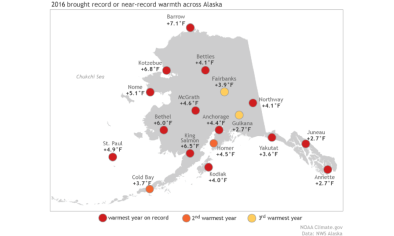


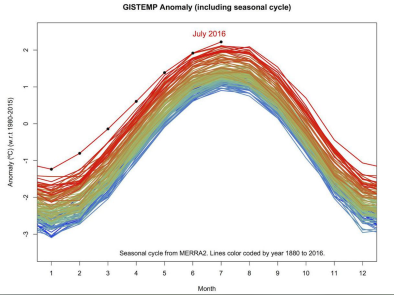
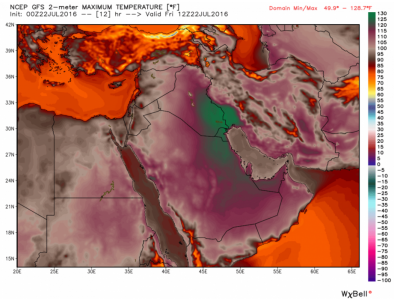
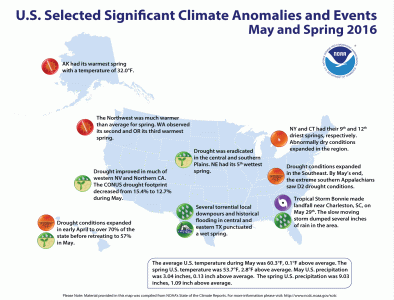
“July 2016 was absolutely the hottest month since the instrumental records began"
Globally, July is the hottest month of the year, and in 2016, it was also the hottest month of any year on record. On August 17, NOAA reported that the globally averaged temperature over land and ocean surfaces for July 2016 was the highest for both the month of July and for any month in the NOAA global temperature dataset record, which dates back to 1880.[1]
July 2016 was also the warmest July in 136 years of NASA records.[2] Gavin Schmidt, who directs NASA's Goddard Institute for Space Studies, stated, "July 2016 was absolutely the hottest month since the instrumental records began."[3]
The Middle East experiences a record-shattering summer
 Observed temperatures in Mitribah, Kuwait reached 129.2°F (54.0°C) on July 21st, the hottest temperature ever measured in the country according to the Kuwait Meteorological Department.[4] Once confirmed the record will also go down as the hottest temperature ever reliably measured outside of Death Valley, California.[5] On July 22nd, Basrah, Iraq reached 128°F (53.4°C) that, once confirmed, will go down as the fourth highest temperature ever reliably measured outside of Death Valley.[5] Parts of the United Arab Emirates and Iran experienced a heat index—or "real feel temperature" that accounts for both air temperature and humidity—that soared to 140°F in July.[6]
Observed temperatures in Mitribah, Kuwait reached 129.2°F (54.0°C) on July 21st, the hottest temperature ever measured in the country according to the Kuwait Meteorological Department.[4] Once confirmed the record will also go down as the hottest temperature ever reliably measured outside of Death Valley, California.[5] On July 22nd, Basrah, Iraq reached 128°F (53.4°C) that, once confirmed, will go down as the fourth highest temperature ever reliably measured outside of Death Valley.[5] Parts of the United Arab Emirates and Iran experienced a heat index—or "real feel temperature" that accounts for both air temperature and humidity—that soared to 140°F in July.[6]
Unlike other parts of the world where climate change has led to milder winters, in the Middle East it has intensified summer extremes.[7]
Even after a year of continually broken heat records, February’s temperature spike shocked many scientists
NOAA data shows that February's global temperature deviated from normal by 2.18°F (1.21°C), which represents the largest departure from average for any month in recorded history. The three month period between December and February also went down as the warmest winter on record. NASA data confirmed both these findings with February's monthly temperature measured at 2.43°F (1.35°C) above the 1951-1980 global average.
The jump was both record-breaking and startlingly large. February was more than 0.2°C higher than the record-breaking 1.15°C departure from the average measured in January. In a setting where records are most frequently broken by slim margins measured in hundredths of degrees, February’s increase was extreme.
NASA’s Gavin Schmidt summed up the feelings of most climate scientists in a word, “Wow.” Even compared to previous El Niño years, 2016’s monthly temperatures are already shattering global heat records, leading many experts to speculate that this year will once again be the hottest ever recorded.
Warmest winter in US history topples more heat records
The winter of 2015-2016 (December through February) was the warmest on record for the continental US, data from NOAA show, as average temperatures climbed nearly 5°F above normal. Every state in the lower 48 saw temperatures at least 1.7°F above average. New England lead the pack, with all six states experiencing the warmest winter ever. Alaska was a “freakish” 10.6°F above average.[8] The previous six months were the warmest such period on record for the contiguous US.
Most of the additional heat reflected in the February measurement came from the oceans, which hold the vast majority of heat accumulated by global warming.[9] That extra heat is now emerging. El Niño acts as the engine in this heat exchange, and global warming provides the extra heat that is driving these record-breaking departures from average.
Related Content
